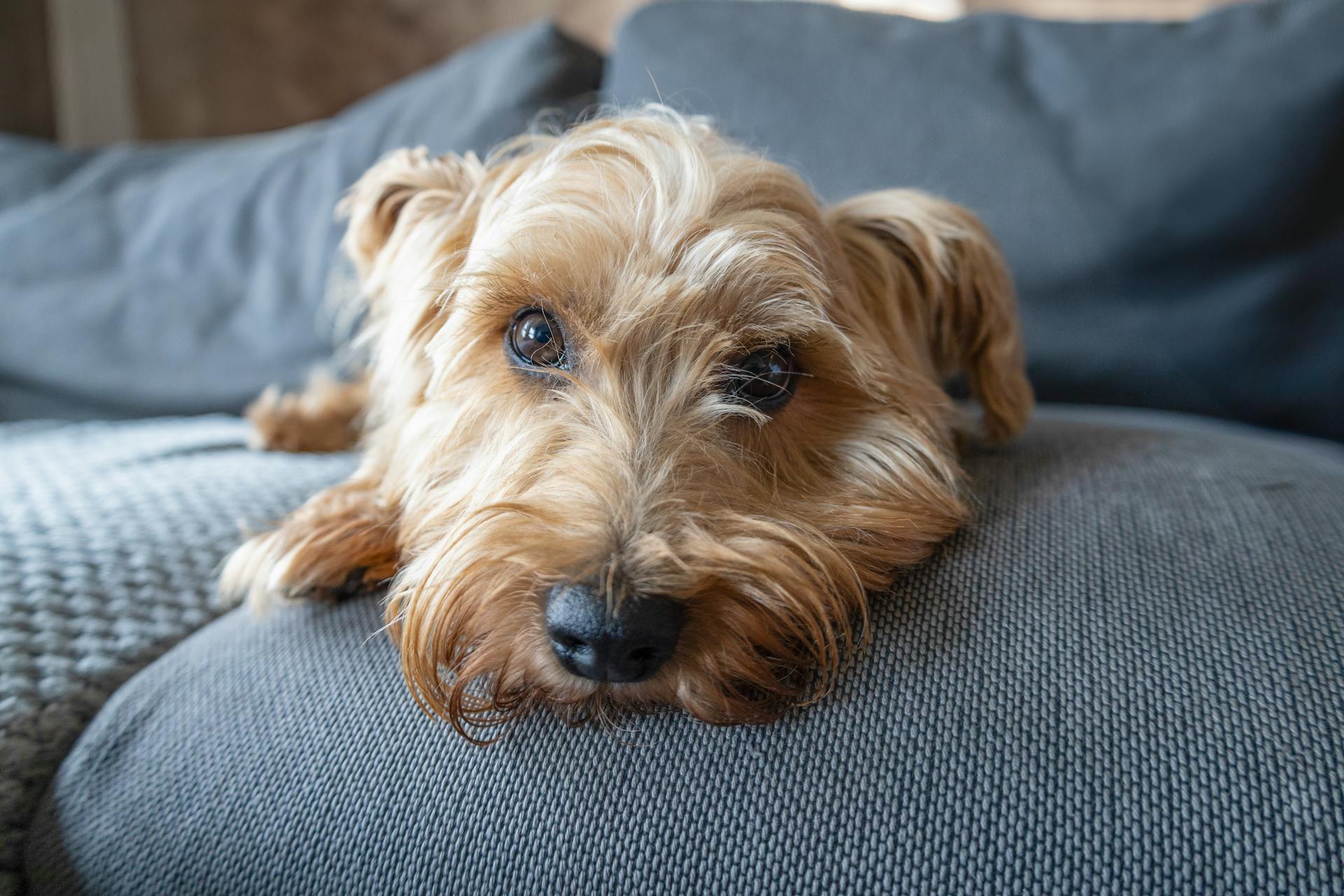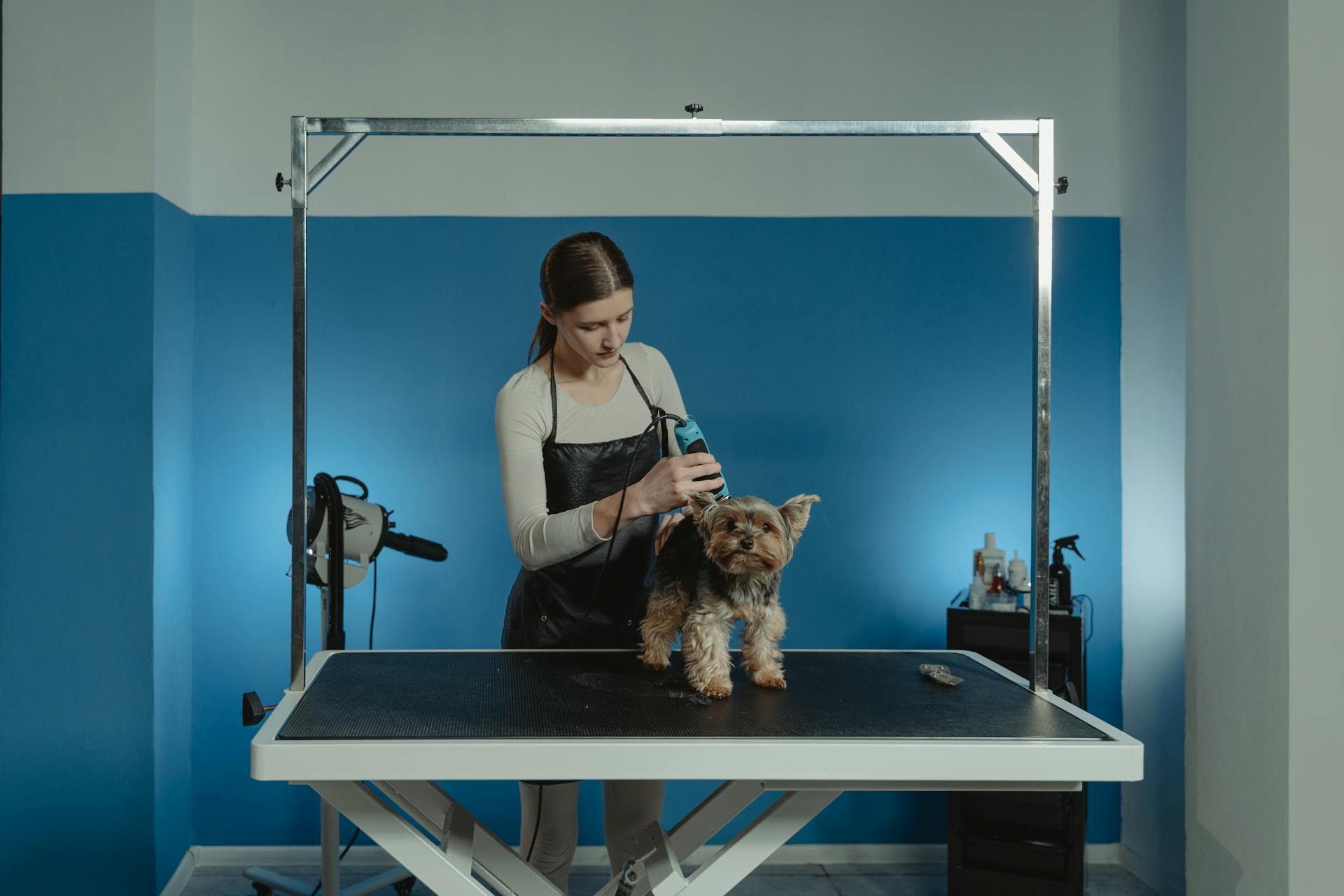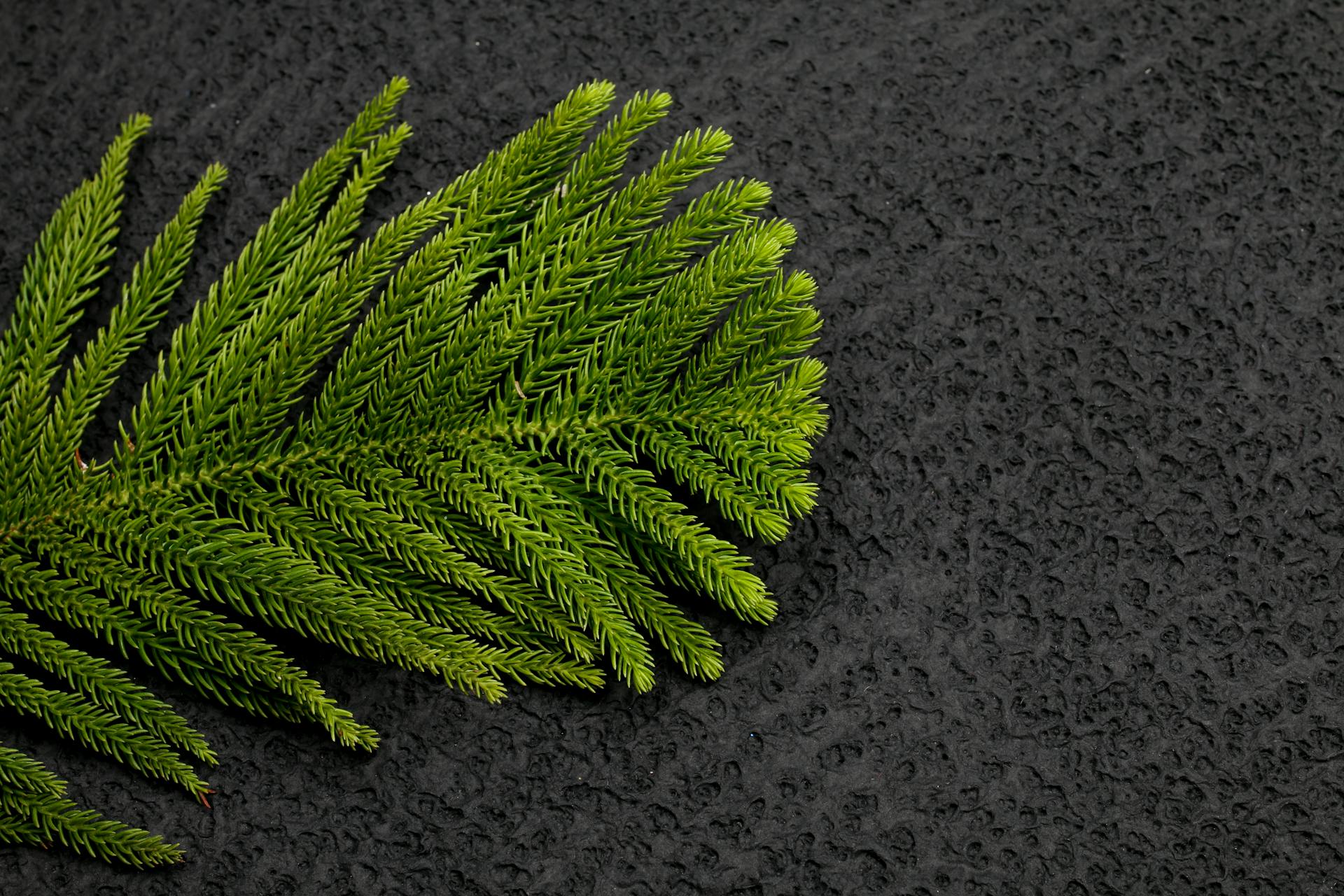
The Norfolk Terrier Rescue is a vital organization that helps find forever homes for these lovable dogs. According to the Norfolk Terrier Club of America, the breed was developed in the 19th century to hunt small game.
The Norfolk Terrier's gentle and affectionate nature makes them a popular choice as family pets. However, their high energy levels require regular exercise and mental stimulation.
If you're considering adopting a Norfolk Terrier, it's essential to understand their specific needs. For example, the breed requires daily walks and playtime, and their short coats require minimal grooming.
About the Breed
The Norfolk Terrier is the smallest of the terrier breeds, but don't let its size fool you - it has great substance for its size.
They were once shown as one breed, known as the Norwich Terrier, until 1964 when they were recognized as two separate breeds.
In 1932, the Norwich Terrier was recognized, with two permissible types of ear: the drop eared variety and the prick eared variety.
The drop eared variety is now known as the Norfolk Terrier, and the prick eared variety is still known as the Norwich Terrier.
The campaign to recognize the two types as separate breeds was quite heated at times, but ultimately successful in 1964.
Care and Feeding
Norfolk terriers are relatively low-maintenance when it comes to grooming, but they do require regular brushing once a week and hand-stripping twice a year.
They're highly sensitive dogs, so it's essential to use consistent, positive training methods to teach them new behaviors.
A daily walk is plenty for these energetic dogs, but they do need regular stimulation to prevent boredom and undesirable behaviors like digging.
Norfolk terriers are voracious eaters and prone to obesity, so it's crucial to monitor their calorie intake and choose high-quality, balanced dog food that meets their individual needs.
They love to be part of the family and don't take kindly to being left alone, so they thrive in homes with plenty of attention and interaction.
Health Needs
Norfolk Terriers are generally healthy dogs, with a lifespan of 12 to 16 years.
However, they can be prone to certain health issues, so it's essential to be aware of them. Hip dysplasia, a condition where the femur doesn't fit snugly into the hip joint, is common in many breeds, including the Norfolk Terrier. Symptoms include a decrease in activity and agility, reluctance to run or jump, and lameness.
Hip dysplasia is often manageable and treatable with physical therapy, joint supplements, and medications. In more severe cases, surgery might be necessary. Regular exercise and a healthy weight can help prevent or manage hip dysplasia.
Patellar luxation, a condition where the kneecap slides in and out of place, can cause pain for your dog. Treatment ranges from weight management and medication to surgery. This condition can be controlled with anti-inflammatories, controlled exercise, and weight management.
- Watch for signs of pain when your dog is moving, such as limping or kicking one of their legs out.
- Consult a vet if you notice any of these behaviors.
- Regular exercise and a healthy weight can help prevent or manage hip dysplasia and patellar luxation.
Other conditions to keep an eye out for include mitral valve heart disease, which can be effectively managed through medication if caught early. This condition often begins with a heart murmur and can eventually lead to congestive heart failure. Regular check-ups with your vet can help catch any potential issues early on.
Feeding
Norfolk Terriers are voracious eaters, so it's essential to monitor their calorie intake to prevent obesity.
Their daily food intake depends on their size, age, build, metabolism, and activity level, so it's best to consult with your veterinarian to determine the right amount.
They love their food, but that means they can easily overeat, leading to weight-related health problems.
To check if your Norfolk Terrier is overweight, look for a visible waistline and feel their ribs without having to press hard.
High-quality commercial dog food is a good choice, but make sure it's complete, balanced, and suitable for their age, activity level, and overall health.
Treats are a no-brainer for Norfolk Terriers, but be mindful of their high calorie content, as it can contribute to obesity and related health issues.
Consult your veterinarian if you're unsure about the best diet for your dog or if you're concerned about their weight.
Living Needs
Norfolk Terriers are adaptable to most living situations, both in urban apartments and rural homes.
They require plenty of regular exercise, regardless of the size of their house or outdoor space.
These compact dogs are good with children, especially if they grow up around little ones.
However, their strong prey drive and independence mean they do best in homes without other small pets.
Norfolk Terriers love to be busy, so they thrive in an active family with kids who enjoy being outdoors.
They're game for short jogs and long, leisurely walks with plenty of good smells.
But they're not suited for longer hikes as their little legs can get tired.
Make sure their outdoor space is secure, as terriers are adept at squeezing through small spaces.
Regular exercise, such as a brisk 30-minute walk every day, should be plenty for these energetic pups.
They're also happy to play fetch and tug-of-war to get the exercise they need.
Mental stimulation counts, too, so try dog puzzles on rainy days.
Always keep your pup on a leash when you're out and about to prevent them from giving chase to small animals.
Norfolk Terriers love to spend time with their human family members and are generally friendly, but may be uncomfortable around new people.
They typically announce the presence of visitors by barking.
These affectionate pups make great travel companions, so bring them along on your next trip.
For your interest: Are Pit Bulls Good Family Dogs
Grooming and Training
Grooming a Norfolk Terrier is relatively easy, but it does require some effort. Brushing their coat at least once a week helps remove loose hair and dirt. Regular nail trimming is also necessary, about once a month.
Norfolk Terriers need to be hand stripped at least twice a year, which can be a bit of a task, but it's worth it for the benefits of a hand-stripped coat, such as shedding dirt and being water-resistant. This means fewer baths for your pup, and baths should be infrequent, ideally once every three months.
To keep their teeth healthy, regular toothbrushing is a must, ideally every day, and their teeth should be professionally cleaned by a vet at least once a year.
You might like: Bedlington Terrier Teeth
Appearance
Norfolk Terriers have a unique appearance that's hard to resist. They typically stand about 10 inches tall and have short legs.
Their coats are wiry and straight, lying close to their body. This double coat is weather-resistant and comes in a variety of colors, including red, red wheaten, black and tan, or grizzle.
Norfolk Terriers have small, dark oval-shaped eyes with black rims. Their noses are typically black and their ears are dropped, hanging neatly and being smooth and velvety to the touch.
Their tails are usually medium length, although the AKC breed standard calls for docking, which is a procedure that involves cutting a portion of the tail off when they're puppies.
Here are the main characteristics of the Norfolk Terrier's appearance:
- Ears: Dropped, v-shaped, and slightly rounded at the tip, hanging neatly and being smooth and velvety to the touch.
- Eyes: Small, dark, and oval with black rims.
- Nose: Typically black.
- Coat: Double, wiry, and straight, lying close to the body and no longer than two inches.
- Coat Color: Red, red wheaten, black and tan, or grizzle.
- Tail: Usually medium length, although docking is a common practice.
Grooming
Grooming is an essential part of owning a Norfolk Terrier, and it's not as daunting as it seems. Regular grooming helps maintain your dog's overall health and appearance.
To start, Norfolk Terriers have a double coat that consists of a soft undercoat and a hard, wiry overcoat. This coat sheds minimally, but it does need to be brushed at least once a week to remove loose hair and dirt. Brushing also helps prevent matting and tangling.
Their coat should be brushed one or twice a week, and it's best to use a bristle brush for this task. Brushing will also help distribute skin oils, keeping the coat healthy and shiny.
Discover more: Smooth Hair Fox Terrier Puppies
In addition to brushing, Norfolk Terriers need regular nail trimming, which should be done about once a month. If you can hear their nails tapping on the floor, it's time for a trim! You should also plan to have their teeth professionally cleaned by a vet at least once a year.
Norfolk Terriers are prone to dental issues, so regular toothbrushing is crucial. Brush their teeth every day, or at least 2-3 times a week, to prevent tartar buildup and gum disease. If your dog is new to toothbrushing, start early and make it a fun experience for both of you.
Here's a summary of the grooming tasks you'll need to perform regularly:
Norfolk Terriers also need to be hand-stripped at least twice a year, in the fall and spring, to remove loose, dead hair. This task can be done by a groomer if you're not comfortable doing it yourself.
Training
Training a Norfolk Terrier requires consistency and patience. Consistency is the key to housebreaking, as they need to go out more frequently due to their small bladders.
Positive reinforcement is an effective way to train a Norfolk Terrier puppy. Offering rewards for good behavior, such as treats, praise, and play breaks with fun toys, will yield the best results.
Taking your pup out about 20 minutes after every meal is crucial for housebreaking. Be sure to use the same cue words, like "Let's go potty", so they start to learn what it means.
Early socialization is essential to help your dog stay calm in the face of new experiences. This will help prevent barking, digging, and chasing smaller animals.
Obedience training is also vital, teaching basic skills like sit, stay, and come. This will help you redirect their undesirable behavior when necessary.
You can't completely train the traits that may test your patience out of your dog, but you can help curb them.
If this caught your attention, see: When Do Yorkshire Terriers Go into Heat
Personality and Lifestyle
The Norfolk Terrier is a lively and active breed that thrives on action. They're always ready to play and can be exhausting to keep up with.
If you're looking for a low-maintenance pet, the Norfolk Terrier is not the breed for you. They require daily exercise and mental stimulation to prevent boredom and destructive behaviors.
Their high energy level means they need plenty of playtime and exercise to keep them happy and healthy. This can be as simple as a walk around the block or a game of fetch in the backyard.
Norfolk Terriers are intelligent and adaptable, making them great companions for families and individuals alike. They love to be active and run and play, but they're also happy to relax at home with their humans.
One thing to keep in mind is that Norfolk Terriers can be reserved around newcomers, so it's essential to socialize them well to prevent any behavioral issues.
Personality
The Norfolk Terrier's personality is a real treat. They're small, but they make up for it with a buoyant, lively approach to life.
They thrive on action, so be prepared to provide it for them – or they'll be bored and unhappy. This means they need regular exercise and playtime to keep them entertained.

Norfolk Terriers are intelligent and incredibly scrappy, which makes them great companions for active families. They're also quite affectionate and loyal to their families.
However, they can be intolerant of boundary issues that come with little humans, so it's essential to teach children how to respectfully interact with dogs. They're also prone to digging and barking, so be prepared for some extra work.
Despite their small size, Norfolk Terriers are bold, brave, and up for adventures. They love to run, play, and be active, but they're also happy to relax at home.
Their high energy level means they hate being bored or left alone, so make sure to keep them well-exercised and mentally stimulated. This will help prevent destructive behaviors like digging and chewing.
Norfolk Terriers are versatile and adaptive, and they're just as happy to accompany their humans on outings as they are to relax at home. Just remember to give them plenty of exercise and playtime first!
For more insights, see: Dachshunds Seeking Forever Home Rescue
Environment

Norfolk Terriers are adaptable to apartment living as long as they receive regular exercise.
They're a social breed that thrives on interaction with their family, and they tend to do well with other dogs.
Supervising young children is crucial to prevent them from playing too roughly with the dog.
Norfolk Terriers have a strong prey drive and may view cats and small pets like ferrets and hamsters as potential targets.
They love to be included in activities and will often express disappointment if left behind.
Leaving them alone for extended periods can lead to destructive behavior, like chewing.
Children and Pets
If you're considering a Norfolk Terrier as a family pet, it's essential to think about how they'll interact with your children. Norfolk Terriers are good with kids, but it's best to wait until they're at least 10 years old, as their small size makes them more vulnerable to accidental harm.
Living with other dogs is generally not a problem for Norfolk Terriers, as they tend to get along well with canine companions. However, their strong prey drive means they're not a good fit for households with small animals like hamsters, gerbils, or birds.
Take a look at this: Small Yorkshire Terrier
Rescue and Support
If you're considering adopting a Norfolk Terrier, you're in luck – there are several rescue groups dedicated to helping these lovable dogs find new homes. The Norfolk Terrier Club and California Norfolk Terrier Rescue are two organizations that work tirelessly to rescue and rehome Norfolk Terriers.
Norfolk Terrier Rescue, Inc. is a 501(c)(3) non-profit organization that helps find new homes for Norfolk Terriers in need. Their mission is to ensure that all Norfolk Terriers have a home, and they welcome dogs from all situations, including shelters and owner surrenders.
If you're interested in adopting a Norfolk Terrier, be sure to check out Norfolk Terrier Rescue, Inc.'s Facebook page, where they post available dogs. They also have an online adoption application process, but be sure to only submit an application when there's a dog posted on their Facebook page.
Here are some key rescue groups to consider:
- Norfolk Terrier Club
- California Norfolk Terrier Rescue
- Norfolk Terrier Rescue, Inc.
Mission Statement
Norfolk Terrier Rescue, Inc. is a 501(c)(3) non-profit organization dedicated to improving the lives and welfare of displaced or homeless Norfolk Terriers. They help find new homes for Norfolk Terriers regardless of circumstance.
Their mission is to ensure that all Norfolk Terriers have a home, to mentor new owners, and to educate the public about the breed. They welcome any Norfolk Terrier in need and serve the entire United States through a network of Norfolk Terrier Club members and valuable friends.
You can submit an adoption application online, but only if there is an available dog posted on their Facebook page, Norfolk Terrier Rescue.
Norfolk Terrier Rescue, Inc. helps dogs in need for many reasons, including death, divorce, failing health, and other family situations. They also work with dogs that wind up in shelters.
The organization's goal is to provide a safe and loving home for every Norfolk Terrier in need.
Here are some ways you can get involved with Norfolk Terrier Rescue, Inc.:
- Visit their Facebook page, Norfolk Terrier Rescue, to see available dogs and learn more about their mission.
- Submit an adoption application online if there is an available dog posted on their Facebook page.
- Consider volunteering or donating to support their efforts.
- Spread the word about the importance of rescue and adoption.
Rescue Groups
Rescue Groups can be a wonderful way to bring a new furry friend into your life. Norfolk Terrier Rescue Groups, such as the Norfolk Terrier Club and California Norfolk Terrier Rescue, are dedicated to rescuing and rehoming these loving dogs.
A unique perspective: Basenji Rescue Groups
If you're considering adopting a Norfolk Terrier, these groups can provide valuable support and guidance throughout the process. They often have a wealth of knowledge about the breed and can help match you with a dog that's a great fit for your lifestyle.
You can also expect to find a variety of resources and services offered by these rescue groups, including adoption events and networking opportunities.
Here are some Norfolk Terrier Rescue Groups you can reach out to:
- Norfolk Terrier Club
- California Norfolk Terrier Rescue
Donations
Donations can be a huge help to organizations like the Norfolk Terrier Rescue (NTR), which is a 501-3C non-profit organization.
Donations are fully responsible for funding the NTR, which is why they're so crucial to the organization's survival.
You can mail your donations to the NTR, and it's worth noting that donations may be tax deductible, but it's always best to check with your tax advisor to confirm.
Every little bit counts, and even small donations can make a big difference in the lives of the dogs in the NTR's care.
Featured Images: pexels.com

